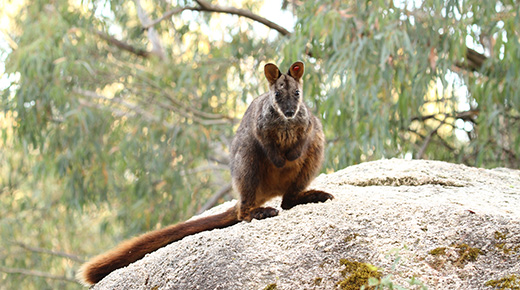
In 2018, the Brush-tailed Rock-Wallaby was named the ACT mammal emblem. Tidbinbilla is the only place in the ACT where Brush-tailed Rock-Wallabies can be found. Before the breeding program, the last Southern Brush-tailed Rock-Wallaby was seen in the wild in the ACT in 1959.
The Brush-tailed Rock-wallaby has a characteristic, long, dark tail that is bushier towards the tip. Brush-tailed rock-wallabies have a white cheek-stripe and a black stripe from its forehead to the back of its head. They are highly agile due to their compact, muscular build and their long tail that they use for balancing. Their feet have heavy padding and texture for their natural habitat that includes rocky escarpments, outcrops, caves and cliffs.
The Brush-tailed rock-wallaby occurs in fragmented populations roughly following the Great Dividing Range from southwest Queensland to western Victoria’s Grampians. They live on rocky escarpments, granite outcrops and cliffs, which have caves and ledges for shelter. They browse on vegetation such as grasses and forbs and the foliage of shrubs and trees.
Threats to brush-tailed rock-wallaby include clearing of vegetation, exotic plant invasion and changed fire regimes. Introduced species such as foxes, goats and rabbits have had a major impact on brush-tailed rock wallabies causing predation and competition. Competition with herbivores means they have to venture out of their normal home range for food. The population declined greatly after European settlement when people hunted the species for their pelts. The Brush-tailed Rock-wallaby is listed nationally as Threatened.
The Brush-tailed Rock-wallaby can be separated into three genetically distinct groups, known as Evolutionary Significant Units (ESUs). These are the:
- Southern ESU found in Victoria
- Central ESU found in Hunter River, South East New South Wales and
- Northern ESU found in South East Queensland and North East New South Wales.
It is estimated there are less than 100 Southern Brush-tailed Rock-wallabies left in the wild in Australia. Tidbinbilla is working to conserve the Southern ESU and currently has approximately 70% of the captive breeding population.
The Southern Brush-tailed Rock-wallaby program was established in 1996 when there was estimated to be less than 20 left in the wild. The initial focus was to build up a captive population as quickly as possible for re-introduction. To achieve this a technique called cross-fostering was used to rapidly accelerate breeding. The technique was highly successful – the captive population grew enough to allow for the first trial re-introduction in 2008 in the Grampians National Park. This method improved our understanding of reintroductions developing novel approaches for improving reintroduction success.
Works are underway to complete a 120 hectare predator-proof enclosure to house up to 100 individuals, giving them the ability to behave as they would in a wild setting, allowing natural processes such as foraging and choosing a mate. This project was made possible after receiving a funding support from our partners Zoos Victoria and the Threatened Species Fund.
Tidbinbilla works with Mount Rothwell Biodiversity Centre in maintaining insurance populations and ensuring that the breeding program is maintaining genetic diversity, rather than boosting individual numbers. In doing this, the program moves away completely from intensive breeding to a natural approach, allowing mate selection and population dynamics to occur as they would in the wild. The Conservation Wildlife team at Tidbinbilla undertake seasonal trapping and monitoring of the species, collecting data on their health and reproduction.
As part of the recovery program, Tidbinbilla has partnered with Zoos Victoria, Mount Rothwell Biodiversity Centre, the Victorian Department of Environment, Land, Water and Planning, Parks Victoria, Adelaide Zoo, Waterfall Springs Sanctuary and the Southern Brush-tailed Rock-Wallaby Recovery Team.
Tidbinbilla partners with ACT PCS Conservation Research branch, as well as a number of organisations collaborating to reduce threats to endangered species and increase survivability upon reintroduction.
You can read more about the Brush-tailed Rock-Wallaby and other animals in our many Threatened Species Action Plans, Threatened Species Factsheests and Threatened Species and Ecological Communities.
